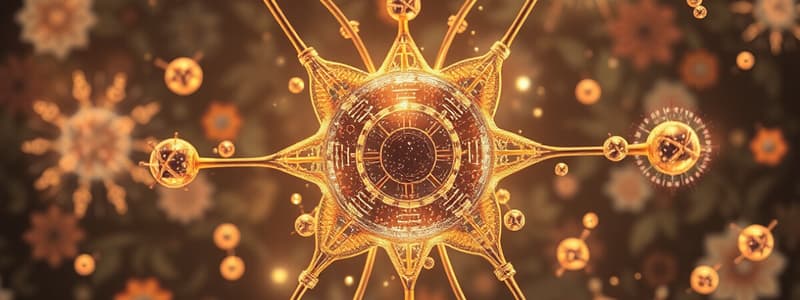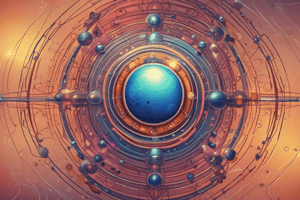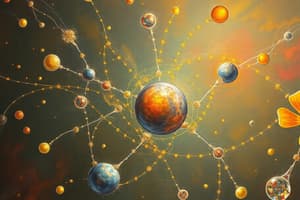Podcast
Questions and Answers
What is the term used by the pros to refer to themselves?
What is the term used by the pros to refer to themselves?
- Electrons
- Protons (correct)
- Neutrons
- Elected Ones
Which gang is described as having a positive attitude?
Which gang is described as having a positive attitude?
- The Elected Ones
- The Pros (correct)
- The New Boys
- The Electrons
What is the main characteristic of the Elected Ones?
What is the main characteristic of the Elected Ones?
- They are friendly.
- They are called neutrons.
- They are positive.
- They have a negative attitude. (correct)
How many members do the pros and the elected ones have in relation to each other?
How many members do the pros and the elected ones have in relation to each other?
What term is used to describe the hangout spot for the pros and the new boys?
What term is used to describe the hangout spot for the pros and the new boys?
What do the new boys call themselves in the context of the discussion?
What do the new boys call themselves in the context of the discussion?
In the context of the gangs, what does 'Dud' refer to?
In the context of the gangs, what does 'Dud' refer to?
Which of the following describes the overall tone of the pros and new boys?
Which of the following describes the overall tone of the pros and new boys?
What is the term used for the empty space occupied by the neighborhood?
What is the term used for the empty space occupied by the neighborhood?
How are the electrons characterized in relation to their behavior?
How are the electrons characterized in relation to their behavior?
What does the atomic number of an element represent?
What does the atomic number of an element represent?
How many protons are in a neutral atom of carbon?
How many protons are in a neutral atom of carbon?
What is the relationship between protons and electrons in a neutral atom?
What is the relationship between protons and electrons in a neutral atom?
How can the number of neutrons be calculated for an element?
How can the number of neutrons be calculated for an element?
What do isotopes of an element have in common?
What do isotopes of an element have in common?
What is the atomic mass of carbon as referenced in the content?
What is the atomic mass of carbon as referenced in the content?
What charge do neutrons have?
What charge do neutrons have?
What is true about the electrons in a neutral atom of oxygen?
What is true about the electrons in a neutral atom of oxygen?
Why are electrons not included in the calculation of atomic mass?
Why are electrons not included in the calculation of atomic mass?
How many neutrons would a neutral atom of oxygen with an atomic mass of 16 have?
How many neutrons would a neutral atom of oxygen with an atomic mass of 16 have?
What would happen to the number of neutrons in isotopes of the same element?
What would happen to the number of neutrons in isotopes of the same element?
Which of the following statements is true regarding atomic mass?
Which of the following statements is true regarding atomic mass?
Why is the atomic number important in a periodic table?
Why is the atomic number important in a periodic table?
What are the three elementary particles that make up an atom?
What are the three elementary particles that make up an atom?
What is the charge of protons in an atom?
What is the charge of protons in an atom?
In an atom, what dictates the overall charge?
In an atom, what dictates the overall charge?
What do neutrons contribute to an atom?
What do neutrons contribute to an atom?
What is the significance of the periodic table?
What is the significance of the periodic table?
How do you define a neutral atom?
How do you define a neutral atom?
Which particle is found in the nucleus and has no charge?
Which particle is found in the nucleus and has no charge?
Where are electrons typically found in relation to the nucleus?
Where are electrons typically found in relation to the nucleus?
When considering an atom with 7 protons, how many electrons would it have if it is neutral?
When considering an atom with 7 protons, how many electrons would it have if it is neutral?
Which particle directly determines the chemical identity of an element?
Which particle directly determines the chemical identity of an element?
What happens to the charge of an atom if it loses an electron?
What happens to the charge of an atom if it loses an electron?
What does a negatively charged atom imply about its electron count?
What does a negatively charged atom imply about its electron count?
What are electrons primarily responsible for in an atom?
What are electrons primarily responsible for in an atom?
Which of the following best describes the structure of an atom?
Which of the following best describes the structure of an atom?
Flashcards
What are atoms?
What are atoms?
Atoms are the fundamental building blocks of all matter, meaning everything in the universe is composed of atoms.
What is the nucleus of an atom?
What is the nucleus of an atom?
The nucleus is the central part of an atom, containing protons and neutrons.
What are protons?
What are protons?
Protons are positively charged particles found in the nucleus.
What are neutrons?
What are neutrons?
Signup and view all the flashcards
What are electrons?
What are electrons?
Signup and view all the flashcards
What is atomic mass?
What is atomic mass?
Signup and view all the flashcards
What is the periodic table?
What is the periodic table?
Signup and view all the flashcards
What is the atomic number?
What is the atomic number?
Signup and view all the flashcards
What is a neutral atom?
What is a neutral atom?
Signup and view all the flashcards
What is a positively charged atom?
What is a positively charged atom?
Signup and view all the flashcards
What is a negatively charged atom?
What is a negatively charged atom?
Signup and view all the flashcards
What is an element?
What is an element?
Signup and view all the flashcards
What is a compound?
What is a compound?
Signup and view all the flashcards
How does the structure of an atom affect its properties?
How does the structure of an atom affect its properties?
Signup and view all the flashcards
How small are atoms?
How small are atoms?
Signup and view all the flashcards
Atomic Number
Atomic Number
Signup and view all the flashcards
Atomic Mass
Atomic Mass
Signup and view all the flashcards
Protons
Protons
Signup and view all the flashcards
Electrons
Electrons
Signup and view all the flashcards
Neutrons
Neutrons
Signup and view all the flashcards
Neutral Atom
Neutral Atom
Signup and view all the flashcards
Calculating Number of Neutrons
Calculating Number of Neutrons
Signup and view all the flashcards
Isotopes
Isotopes
Signup and view all the flashcards
Electron Shell
Electron Shell
Signup and view all the flashcards
Chemical Bonding
Chemical Bonding
Signup and view all the flashcards
Electron Configuration Diagram
Electron Configuration Diagram
Signup and view all the flashcards
Valence Shell
Valence Shell
Signup and view all the flashcards
Valence Electrons
Valence Electrons
Signup and view all the flashcards
Stable Electron Configuration
Stable Electron Configuration
Signup and view all the flashcards
Ionization
Ionization
Signup and view all the flashcards
Gang
Gang
Signup and view all the flashcards
Hangout
Hangout
Signup and view all the flashcards
Nothing
Nothing
Signup and view all the flashcards
Negative
Negative
Signup and view all the flashcards
Positive
Positive
Signup and view all the flashcards
Nucleus
Nucleus
Signup and view all the flashcards
Neighborhood
Neighborhood
Signup and view all the flashcards
Study Notes
Atomic Structure Basics
- Atoms are the fundamental building blocks of all matter.
- Everything, from objects to living things, is composed of atoms.
- Atoms consist of three main particles: protons, neutrons, and electrons.
Subatomic Particles
- Protons: Positively charged particles located in the nucleus (center) of the atom.
- Electrons: Negatively charged particles found outside the nucleus, orbiting in undefined paths.
- Neutrons: Neutral particles (no charge) located in the nucleus. They contribute to the atom's mass.
Atomic Nucleus
- The nucleus contains protons and neutrons.
- The nucleus is the central part of the atom.
Electron Orbitals
- Electrons are not in fixed, circular orbits, but are instead found in an electron cloud around the nucleus. Simplified diagrams often show electrons orbiting in rings for clarity.
- The space between the nucleus and the electrons is essentially empty space.
Atomic Number and Mass
- The atomic number is the number of protons in an atom. It's a whole number located on the top of an element's box on the periodic table.
- A neutral atom has the same number of protons and electrons.
- Atomic mass is the total number of protons and neutrons in an atom (represented by the decimal number on an element’s periodic table box).
- To calculate the number of neutrons, subtract the number of protons from the atomic mass.
Periodic Table of Elements
- The periodic table displays all known elements.
- The arrangement of elements on the periodic table is based on their atomic numbers.
- The properties of elements are related to their positions on the table.
- Various combinations of elements form different compounds from the mundane to the complex, including those found in nature and in man-made objects.
Isotopes
- The number of neutrons in an atom can vary. Atoms with the same number of protons but a different number of neutrons are called isotopes.
Studying That Suits You
Use AI to generate personalized quizzes and flashcards to suit your learning preferences.




